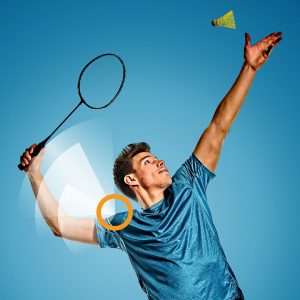Common Badminton and Pickleball Injuries

Badminton and pickleball have exploded in popularity over the last few years, and it’s no surprise. Both are fun to play and easy to learn, making them popular sports with individuals of all ages. Since badminton and pickleball are non-contact sports, they are great ways to support a healthy lifestyle with minimal risks.
Still, with all that time spent on the court, players can be vulnerable to some common overuse injuries. To help you play your best and feel your best, our licensed physical therapists—Nicole Kerr, PT, DPT, Amanda Rubino, PT, DPT, and Samantha Speziale, PT, DPT—explain the most common badminton and pickleball injuries, what you can do to prevent them and how to treat them.
Types of Pickleball and Badminton Injuries
Some injuries, like a fall or slip, are unavoidable. These injuries usually result in an acute condition, like fractures or sprains, where we feel immediate pain and swelling.
But what happens if the injury is not as apparent? When that’s the case, you may have an overuse injury. These injuries result from the strain of repetitive motions without enough rest or recovery. They can be the results of overuse, misuse, or lack of treatment—and since badminton and pickleball are noncontact sports, they tend to be the most common injuries among players.
These are the most common badminton and pickleball injuries, their symptoms, and how to treat them.
Achilles Tendinitis
Achilles tendinitis is an overuse injury to the Achilles tendon, which connects the calf muscle to the heel bone. Individuals with this condition may feel chronic, achy pain that worsens with activity and is tender to the touch at the back of the ankle.
Treatment for Achilles tendinitis may include rest, ice, and temporary changes to your activity or lifestyle to give the tendon time to recover. When the pain subsides, a foot and ankle specialist can discuss additional treatment and rehabilitation to prevent future injuries, including specific stretches and exercises to restore mobility in the ankle.
Patellar tendinitis
Patellar tendinitis is an injury to the patella tendon that connects your kneecap to your shinbone. This overuse injury is generally the result of excessive running and jumping but can also result from muscular imbalance. Symptoms may include tenderness below the kneecap and pain with repeated knee bending.
Initial treatment of patellar tendinitis begins with pain relief and usually includes ice, rest, and modification to activity. Once pain is managed, physical therapy is generally prescribed to reduce the risk of future injuries. Plans start gradually and increase in intensity over time, first with stretches, then strengthening activities to ensure the muscles in your legs are better conditioned to handle the stresses that cause patellar tendinitis.
Tennis elbow (Lateral Epicondylitis)
Like tennis, badminton and pickleball require repetitive arm and wrist movements, making tennis elbow or lateral epicondylitis a common injury among players. This painful condition occurs when the tendons connecting your elbow to your wrist are damaged from overuse.
Symptoms of tennis elbow include pain and tenderness from the outside of your elbow into your forearm and wrist. The condition may also make it difficult or painful to pick up objects, turn door knobs, and complete other everyday tasks.
Like other overuse injuries, treatment begins with managing pain, resting, icing, and limiting activity with the injured arm. After minimizing pain and inflammation, your orthopedist may recommend physical or occupational therapy. Treatment includes stretches and manual therapies to reduce tendon tension, with exercises to restore and improve strength and mobility.
Rotator cuff tear
Your rotator cuff is a group of muscles and tendons that stabilizes your shoulder and allows you to lift and rotate your arms. Rotator cuff tears can vary in intensity, and there are two main types:
- Partial rotator cuff tears, where one or some of the muscles and tendons are injured
- Complete rotator cuff tears, where the tear goes all the way through the tendons and muscles
With rotator cuff tears, pain often presents in the front and sides of the shoulder, and it can be difficult to raise your arm (especially above your head), complete everyday tasks, and carry or lift items. A shoulder specialist can evaluate your injury and treatment options.
With partial tears, physical therapy can progressively increase shoulder joint stabilization, range of motion, strength, and functionality, which can help patients avoid surgery. In some cases, shoulder surgery may be necessary – although there are many minimally invasive treatment options, including the groundbreaking Stryker InSpace Balloon Implant.
Physical Therapy to Prevent Badminton & Pickleball Injuries
The most common injuries in badminton and pickleball result from overuse and misuse, and physical therapy can help with both and even prevent future injuries.
At Orlin & Cohen, our physical therapists create custom rehabilitation plans to ease pain, build strength and improve function. They can also complete thorough movement screenings to identify and address balance dysfunctions, flexibility deficits, and other muscular limitations that may contribute to the likelihood of an injury and prescribe treatment to correct it.
Treatment of Badminton and Pickleball Injuries
Regardless of your injury or how severe you think it is, you should never play through pain. Instead, seek medical advice as soon as possible. Undiagnosed injuries can be reaggravated easily and put you at higher risk for further injury or damage, which can significantly impact your health.
At Orlin & Cohen, our premier team of fellowship-trained orthopedic specialists in sports medicine, foot and ankle, hand, wrist and elbow, shoulder, and knee has the expertise and experience to help you feel better, faster. With a network of offices open seven days a week, it’s easy and convenient to get the comprehensive care you need with same-day appointments and walk-in, after-hours care in case of an accident or a strain at a weekend match.
Want to learn more about sports-related injuries? Read our blog on common athletic injuries and how to prevent them.



